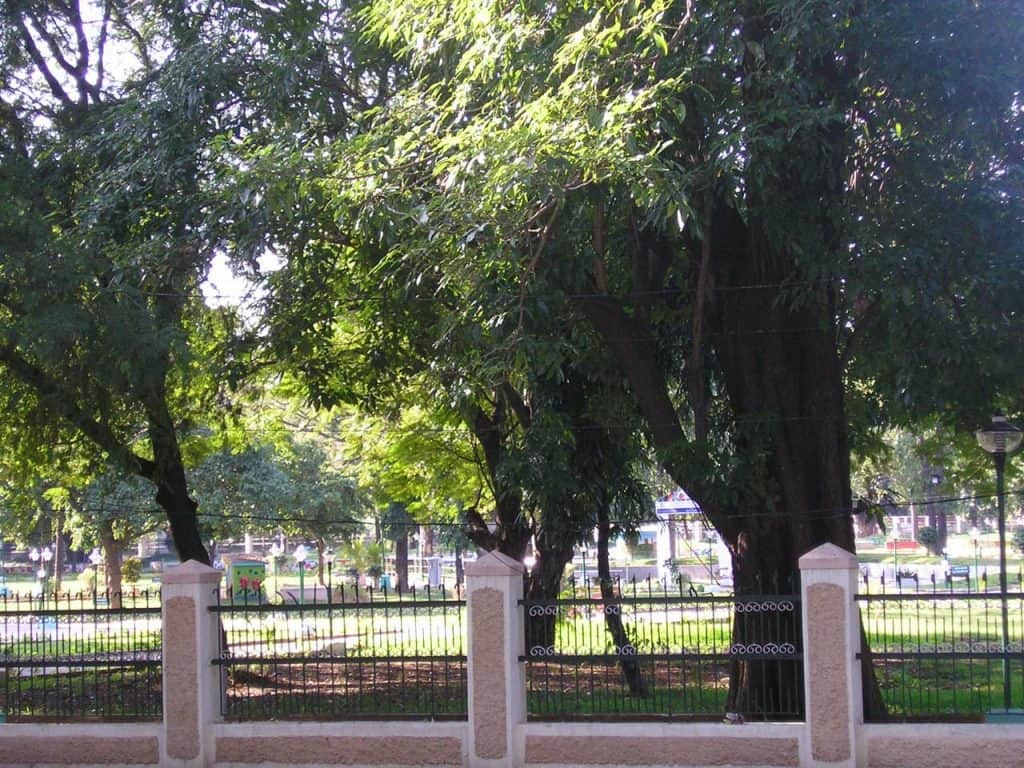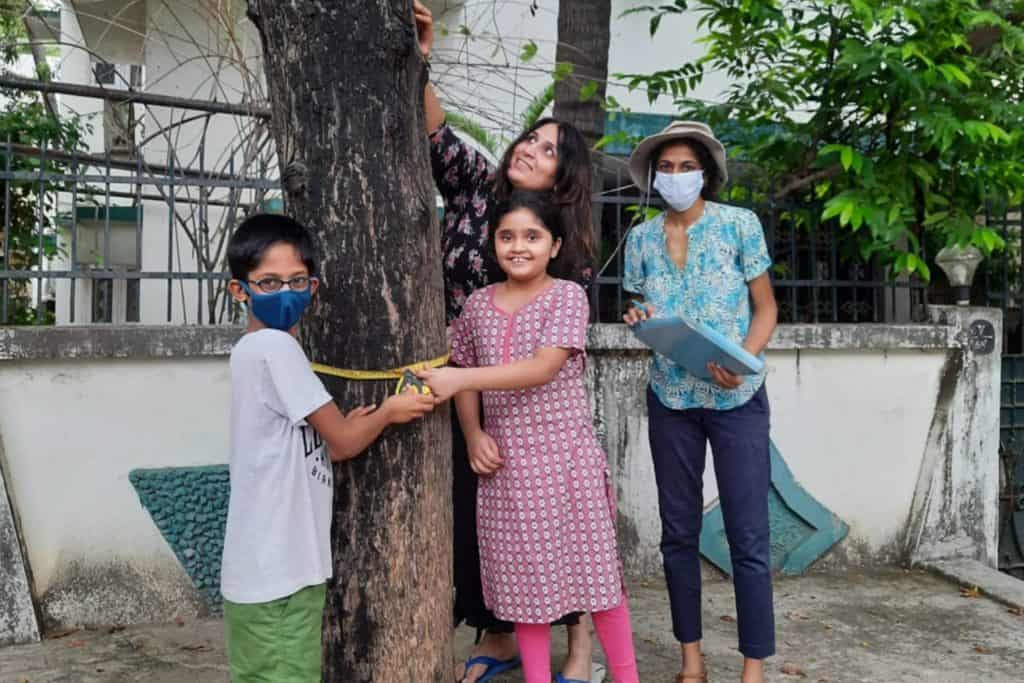How do you know if a tree in your neighbourhood is ‘Ok’! Though trees can drop several hints when they are not ‘feeling fine’, one may have to keenly look at them to understand their condition. The residents of Chennai are doing just that as they participate in a city-wide tree survey, initiated by Nizhal, an NGO that focuses on tree conservation in the city. The initiative aims at making an inventory of trees in the city through local tree surveys that can indicate the extent of tree diversity in the city and the status of tree health.
A tree survey also helps to identify the default location of heritage trees, including rare, endangered and bio-geographically significant trees. “This data can help in chalking out a strategy to conserve, protect, treat trees, besides planting the correct species at the right location. Tree abuse details could be compiled and brought to the notice of officials concerned,” says Shobha Menon, Founder Trustee of Nizhal.
Read more: Creating cooler shades for Chennai: A chat with the Founder of Nizhal
Citizen participation
Translating these ideas into practice through the tree survey initiative, residents of areas like Kilpauk, K K Nagar, Mambalam, Porur, Mugalivakkam, Madhavaram have embarked on a mission to take stock of the trees in their neighbourhood and observe how they are doing, under the guidance of Nizhal.
The initiative has garnered enthusiastic response from people of different age groups across neighbourhoods. For many it evokes a bygone age when they were more connected to their natural surroundings.
Talking about his childhood memories, 65-year-old Hari Ratan, a volunteer from Kilpauk, recollects the bond he developed with trees as a child “My father used to insist that we water the rain trees outside our house,” he said.
Nine-year-old Advaith from Anna Nagar is creating memories with trees along with his parents Kirthana and Vedant. “It is fun to hug the trees and learn their common and scientific names,” says Vedant, as he and his friends measure the circumference of trees with measuring tape.
“Once people from all the areas get involved, we can complete the survey sooner. I hope the government also comes forward to assist us,” says Dr TD Babu, trustee of Nizhal, who adds that anybody in Chennai can sign up for the survey.
How can you take part in the tree survey?
The purpose of Nizhal’s tree survey is to empower communities to take charge of their spaces, compile the data and alert the authorities concerned about various problems pertaining to the trees, including tree abuse, says Avni Mohindra, programme coordinator of the tree survey.
The survey includes:
- Identification of the species of the tree: In case citizens fail to identify the species, they can click a picture and send it to a WhatsApp group created to guide the surveyors.
- Ascertaining the approximate age of the tree and categorising them according to age: Young (Y) – less than ten years of age; Matured (M) – aged between 10-30 years; Old (O) – above 30 years
- Approximation of the height of the tree, canopy diameter and the tree circumference
- Determining the health of the trees: Surveyors should look out for symptoms like sawdust, holes of uniform size, mushrooms on the trunk or branch, abnormal drooping and unseasonal withering of leaves
- Reporting tree abuse: If the trees are choked by paving, stressed by nails or cables, restrained by tree guards or carelessly chopped, the tree is said to be abused. This may lead to disease, eventually killing the trees. When volunteers identify cases of tree abuse, they must intimate the corporation by calling 1913.

To participate in the tree survey, a resident can mail nizhal.shade@gmail.com or message them on Instagram @nizhalshade. Once a resident sends them a message, or mails them expressing their interest to participate in the survey, Nizhal mails them a survey form.
“They mail back the filled form to us. One of our participants also shared an Excel sheet compiling their primary data findings. They have the option to do that as well and mail it back,” says Avni.
Participants in the exercise will have to note and fill in details about the trees in their neighbourhood, name of their locality, street etc. Members of Nizhal insist that the volunteers now must follow the COVID protocol strictly while conducting the survey.
Why is the survey important?
The concept of tree survey is not new in Chennai, as Nizhal had undertaken a similar survey in Ward 176 in 2015. At the time, the organisation had collaborated with a transmission line construction company, Teems India while doing the survey in ward 176. “We integrated the type, health status and the age of the trees along with GPS technology, and defined the tree’s position in a satellite map,” says Teems India MD, GR Ravi.
Tree surveys can be done with researchers or experts too, but the organisation believes that if done with community participation, the survey will help the people develop awareness and become mindful of the surrounding green cover. “In Natesan Park, for example, there is a Paneer flower tree, from which you get the flavour of Paneer soda. Even walkers and regular visitors to that park are not aware of its existence or what tree it is. When the community starts doing such work, they develop connections with the trees,” suggests T D Babu.
Shobha feels that trees in Chennai city are facing a constant threat of ‘murder’! “Currently, there is no tree inventory for all the 200 wards of Chennai, under the purview of the Greater Chennai Corporation(GCC). No records or inventory means no check at all! How can we let our guardians and sentinels of our city’s health be in such a state?” she says.
Read more: Opinion: Chennai needs a law to save its green lungs
The narrative Nizhal wants to change
In 2016, after Cyclone Vardah ravaged Chennai, Nizhal took a fresh stock of trees in Ward 176 where they had conducted the survey in 2015. The findings indicated that 16% of these trees had been damaged in the cyclone. About 69.5% of the damaged trees were exotic species like Copper Pod, Rain Trees, Elephant Ear Pod, Gulmohar etc. Indigenous trees, however, withstood the impact of the cyclone.
Read more: Here’s what you must know before you plant another tree in Chennai
Based on the Cyclone Vardah experience, the organisation feels that the exotic species are unsuitable for planting along avenue roads. According to Pauline Deborah, a professor of botany at Women’s Christian College quoted in The Hindu, exotic species are vulnerable, particularly in the monsoon when they may topple, leading to accidents and damage to properties.
But these species, brought in by British botanists during the colonial period, have become so dominant today that people often mistake them as native ones. When Avni Mohindra put up a quiz on the Instagram page of Nizhal, a lot of people identified Rain Tree, Gulmohar, Copper Pod as native trees, because that is mostly what they see around them.
“That is the narrative we want to change. We want people to pay attention to and plant more indigenous trees. These trees are sturdy and will hold their ground when natural calamities occur,” says Avni.
The survey appears to have made some headway in that by making citizens more aware. Kirthana has told her son Advaith not to plant exotic trees like Gulmohar as they have shallow roots and may tend to get uprooted easily, encouraging him instead to plant native, hardy trees like neem.
Plans for the future
The survey itself is not a difficult process as the Nizhal team members mentor citizens at each step, as Kirthana points out. But “Tree conservation is an ongoing process. So after this initial enthusiasm, ensuring that residents and children continue to remain concerned and look after the welfare of the trees in their streets, is a challenge. That will happen only when they take active ownership of their neighbourhood issues,” she adds.
Babu emphasises the importance of human resources to ensure both comprehensiveness and efficacy. “More manpower is needed to complete the exercise within a short span as it is important to cover all trees at the earliest; otherwise, even before the survey is completed, we may lose more trees without any accountability.”
According to a recent order of the Tamil Nadu government, Green Committees have been formed at state and district levels to look after planting and cutting of trees in public places. Their responsibilities include planting of native species, removal of exotic species and taking up a tree census in the state.
Calling this a landmark move by the government, Shobha urges citizens to come together and protect the trees. When asked whether Nizhal would be collaborating with the government in tree mapping, she says that the organisation would be happy to join hands.
